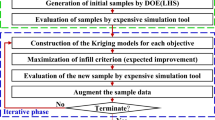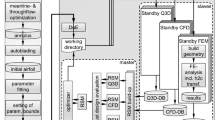Abstract
To improve the optimization accuracy and efficiency, state variable and optimization potential-based multi-objective optimization (MOP) method is introduced. State variable records whether the simulation failed, which caused by ill geometry and mismatched predetermined boundary condition, and is consequently incorporated into objective function through weighted average method to improve the accuracy of surrogate model and optimization. Optimization potential, which represents the difference between present performance and ideal optimal objective, can be used to direct MOP and avoids the manual selection of weight vectors. Four optimization cases, including traditional weighted optimization, state variable based optimization, optimization potential based optimization, and the optimization combined presented two methods, are applied to optimize a typical compressor blade airfoil and demonstrate the proposed optimization method. Results show that the combination of these two methods produces the best optimization result. In which the state variable method generates most of improvement in optimal performance and the optimization potential method notably improves optimal performance under large incidences. The introduction of state variable excludes the invalid objective values at one sample point rather than directly removing or keeping, so that the accuracy of surrogate model is significantly improved and obtains better optimal results. The distribution of optimization potential among each incidence is similar to that of weight vector. Using its summation to construct objective function can be deemed as automatically assigning a preferable weight vector and the optimal result consequently presents slight preferable performance.

















Similar content being viewed by others
References
Casoni M, Magrini A, Benini E (2019) Supersonic compressor cascade shape optimization under multiple Inlet Mach operating conditions. Aerospace 6(6):64
Chang H, Zhu F, Jin D, Gui X (2015) Effect of blade sweep on inlet flow in axial compressor cascades. Chin J Aeronaut 28(1):103–111
Chen J-P, Hathaway MD, Herrick GP (2008) Prestall behavior of a transonic axial compressor stage via time-accurate numerical simulation. J Turbomach 130(4):041014
Chen Q, Ni J, Wang Q, Shi X (2019) Match-based pseudo-MAP full-operation-range optimization method for a turbocharger compressor. Struct Multidisc Optim 60(3):1139–1153
Cheng J, Chen J, Xiang H (2019) A surface parametric control and global optimization method for axial flow compressor blades. Chin J Aeronaut 32(7):1618–1634
Coello CAC, Lamont GB, Van Veldhuizen DA (2007) Evolutionary algorithms for solving multi-objective problems. Springer, New York
Dinh C-T, Ma S-B, Kim K-Y (2017) Aerodynamic optimization of a single-stage axial compressor with stator shroud air injection. AIAA J 55(8):2739–2754
Forrester AIJ, Sóbester A, Keane AJ (2006) Optimization with missing data. Proc R Soc A 462(2067):935–945
Haixiang G, Yijing L, Shang J, Mingyun G, Yuanyue H, Bing G (2017) Learning from class-imbalanced data: review of methods and applications. Expert Syst Appl 73:220–239
He Y, Sun J, Song P, Wang X (2020) Dual Kriging assisted efficient global optimization of expensive problems with evaluation failures. Aerosp Sci Technol 105:106006
He Y, Sun J, Song P, Wang X (2021a) Multi-objective efficient global optimization of expensive simulation-based problem in presence of simulation failures. Eng Comput 38:2001–2026
He Y, Sun J, Song P, Wang X (2021b) Variable-fidelity expected improvement based efficient global optimization of expensive problems in presence of simulation failures and its parallelization. Aerosp Sci Technol 111:106572
Huppertz A, Flassig PM, Flassig RJ, Swoboda M (2007) Knowledge based 2D blade design using multi-objective aerodynamic optimization and a neural network. In: ASME Turbo Expo 2007: power for land, sea, and air, 2007, pp 413–423
Kim J-H, Ovgor B, Cha K-H, Kim J-H, Lee S, Kim K-Y (2014) Optimization of the aerodynamic and aeroacoustic performance of an axial-flow fan. AIAA J 52(9):2032–2044
Knowles J (2006) ParEGO: a hybrid algorithm with on-line landscape approximation for expensive multiobjective optimization problems. IEEE Trans Evol Comput 10(1):50–66
Li Z, Zheng X (2017) Review of design optimization methods for turbomachinery aerodynamics. Prog Aerosp Sci 93:1–23
Li L, Wan H, Gao W, Tong F, Li H (2019a) Reliability based multidisciplinary design optimization of cooling turbine blade considering uncertainty data statistics. Struct Multidisc Optim 59(2):659–673
Li X, Zhao Y, Liu Z (2019b) A novel global optimization algorithm and data-mining methods for turbomachinery design. Struct Multidisc Optim 60(2):581–612
Liu B, Shi H, Yu X (2018) A new method for rapid shock loss evaluation and reduction for the optimization design of a supersonic compressor cascade. Proc Inst Mech Eng G 232(13):2458–2476
Lubenstein JHR, Brian A, Ross AK (1984) Airfoil shape for arrays of airfoils. United States 4431376
Luo J, Liu F (2015) Multi-objective optimization of a transonic compressor rotor by using an adjoint method. AIAA J 53(3):797–801
Marler RT, Arora JS (2010) The weighted sum method for multi-objective optimization: new insights. Struct Multidisc Optim 41(6):853–862
Martin I, Hartwig L, Bestle D (2019) A multi-objective optimization framework for robust axial compressor airfoil design. Struct Multidisc Optim 59(6):1935–1947
Mazaheri K, Khatibirad S (2018) Optimization of bump and blowing to control the flow through a transonic compressor blade cascade. Shock Waves 28(2):285–297
Meng F, Li K, Guo P, Wang K, Li J (2022) Multi-objective shape optimization of transonic compressor cascade at the same inlet Mach number. J Chin Inst Eng 45(5):465–475
Mengistu T, Ghaly W (2008) Aerodynamic optimization of turbomachinery blades using evolutionary methods and ANN-based surrogate models. Optim Eng 9(3):239–255
Qin S, Wang S, Wang L, Wang C, Sun G, Zhong Y (2021) Multi-objective optimization of cascade blade profile based on reinforcement learning. Appl Sci 11(1):106
Sacher M, Duvigneau R, Le Maître O et al (2018) A classification approach to efficient global optimization in presence of non-computable domains. Struct Multidisc Optim 58(4):1537–1557
Savage DJ, Feng Z, Knezevic M (2021) Identification of crystal plasticity model parameters by multi-objective optimization integrating microstructural evolution and mechanical data. Comput Methods Appl Mech Eng 379:113747
Schreiber H-A, Steinert W, Sonoda T, Arima T (2004) Advanced high-turning compressor airfoils for low Reynolds number condition—Part II: experimental and numerical analysis. J Turbomach 126(4):482–492
Song P, Sun J, Wang K (2014) Axial flow compressor blade optimization through flexible shape tuning by means of cooperative co-evolution algorithm and adaptive surrogate model. Proc Inst Mech Eng A 228(7):782–798
Song W, Zhang Y, Chen H, Deng K (2019) Transonic compressor blade optimization integrated with circumferential groove casing treatment. J Turbomach 141(3):031015
Sonoda T, Yamaguchi Y, Arima T, Olhofer M, Sendhoff B, Schreiber H-A (2004) Advanced high turning compressor airfoils for low Reynolds number condition—Part I: design and optimization. J Turbomach 126(3):350–359
Steinert W, Eisenberg B, Starken H (1991) Design and testing of a controlled diffusion airfoil cascade for industrial axial flow compressor application. J Turbomach 113(4):583–590
Sun X, Yang S, Zhao Q (2015) Shock loss model and blade profile optimization design of a supersonic cascade. Proc Inst Mech Eng G 229(7):1325–1329
Venturelli G, Benini E (2016) Kriging-assisted design optimization of S-shape supersonic compressor cascades. Aerosp Sci Technol 58:275–297
Wang XD, Hirsch C, Kang S, Lacor C (2011) Multi-objective optimization of turbomachinery using improved NSGA-II and approximation model. Comput Methods Appl Mech Eng 200(9):883–895
Wilke G (2019) Variable-fidelity methodology for the aerodynamic optimization of helicopter rotors. AIAA J 57(8):3145–3158
Xu H, Chang H, Jin D, Gui X (2017) Blade bowing effects on radial equilibrium of inlet flow in axial compressor cascades. Chin J Aeronaut 30(5):1651–1659
Yue S, Wang Y, Wang H (2018) Design and optimization of tandem arranged cascade in a transonic compressor. J Therm Sci 27(4):349–358
Zhang H, Wu Y, Li Y (2019) Mechanism of compressor airfoil boundary layer flow control using nanosecond plasma actuation. Int J Heat Fluid Flow 80:108502
Zuhal LR, Palar PS, Shimoyama K (2019) A comparative study of multi-objective expected improvement for aerodynamic design. Aerosp Sci Technol 91:548–560
Acknowledgements
This work is supported by National Science and Technology Major Project (2017-II-0006-0019), National Natural Science Foundation of China (Grant No. 51975471), Science Center for Gas Turbine Project(P2022-III-003-002), Shaanxi Science Foundation for Distinguished Young Scholars (Grant No. 2022JC-36) and Innovation Foundation for Doctor Dissertation of Northwestern Polytechnical University (CX2022041).
Author information
Authors and Affiliations
Corresponding author
Ethics declarations
Conflict of interest
The authors declare that there is no conflict of interest.
Replication of Results
Code and data for replication can be provided up on request.
Additional information
Responsible Editor: Nathalie Bartoli
Publisher's Note
Springer Nature remains neutral with regard to jurisdictional claims in published maps and institutional affiliations.
Rights and permissions
Springer Nature or its licensor (e.g. a society or other partner) holds exclusive rights to this article under a publishing agreement with the author(s) or other rightsholder(s); author self-archiving of the accepted manuscript version of this article is solely governed by the terms of such publishing agreement and applicable law.
About this article
Cite this article
Li, H., Zhang, Z., Li, L. et al. State variable and optimization potential-based multi-objective optimization method and application in compressor blade airfoil design. Struct Multidisc Optim 66, 165 (2023). https://doi.org/10.1007/s00158-023-03625-6
Received:
Revised:
Accepted:
Published:
DOI: https://doi.org/10.1007/s00158-023-03625-6




